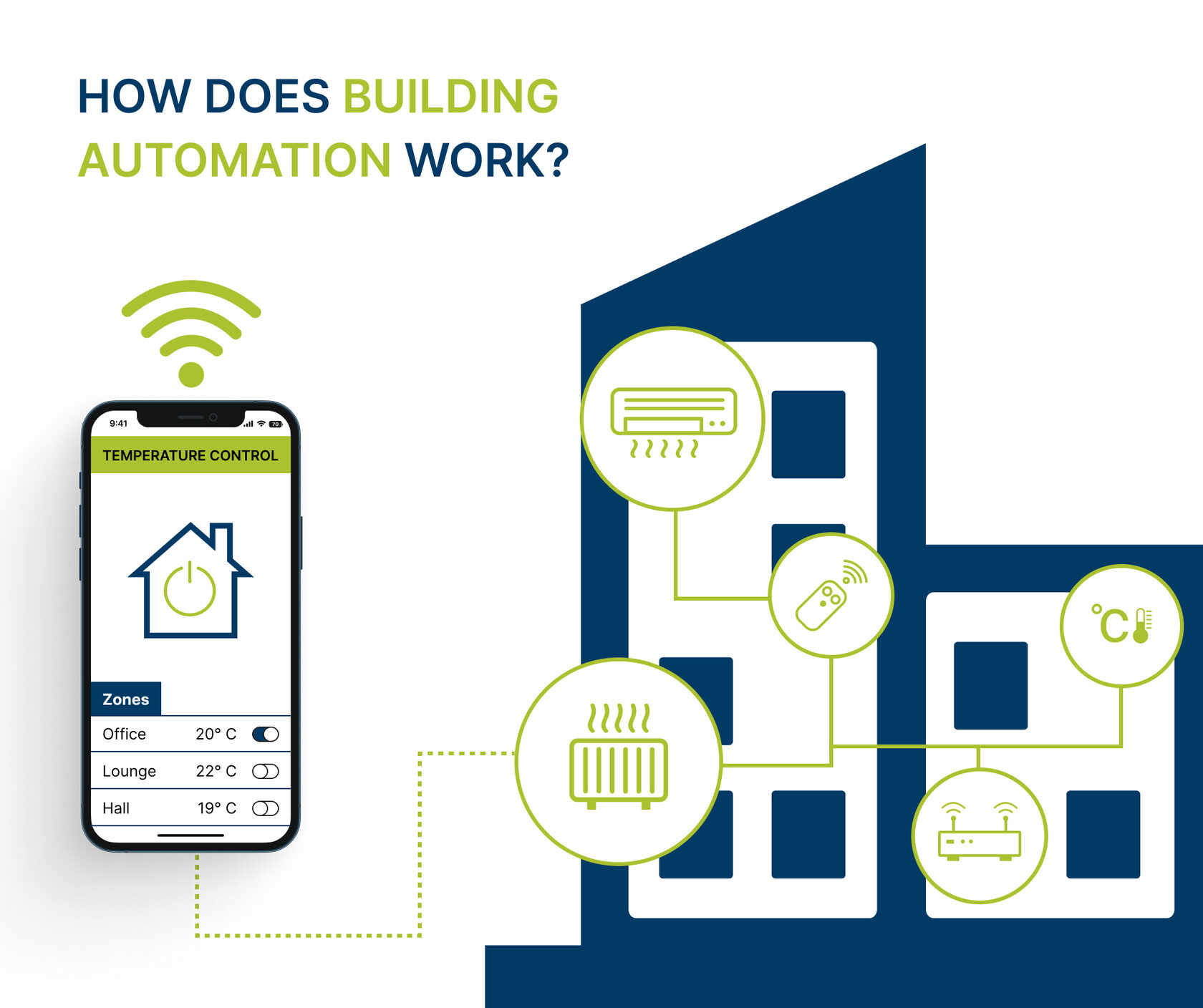What is building automation?
Building automation is the application of technological systems and processes to make a building autonomous and efficient. In simpler terms, building automation means that the building "knows" when to turn on the lights, adjust the heating or other functions using technology and sensors. It helps to save energy, making the building more comfortable and efficient. It is especially important for offices to implement building automation systems to reduce energy costs, improve the work environment, increase safety and promote sustainable business.
How does it work?
Building automation is based on several basic principles that ensure efficient building management and resource optimization. These principles include:
To better understand the basic principles of building automation, let's look at a couple of examples that show how building automation works in a building.
These examples demonstrate how building automation responds to real-world conditions by adapting building systems to optimize comfort and resource use, but they are not all the benefits of building automation systems.
- Sensors: Data collection begins with various sensors, such as temperature, which monitor environmental conditions.
- Data processing and analysis: Collected data is transmitted to a central data processing system where analysis takes place, for example the system identifies trends.
- Decision Making: Based on data analysis, automated systems make decisions about the regulation or operation of specific systems.
- Use of Actuators: Decisions are implemented with automated actuators, which are electromechanical or electronic devices capable of regulating or controlling physical elements.
- Integration and harmonization: All systems and components are integrated and harmonized into a single system.
To better understand the basic principles of building automation, let's look at a couple of examples that show how building automation works in a building.
- If the sensors register that the number of people in the room has increased and the concentration of CO2 has increased, the system can automatically increase ventilation to improve air quality.
- If the sun shines intensely during the day, automated blinds can automatically adjust the angle to reduce excess heat and reduce the need for a cooling system.
These examples demonstrate how building automation responds to real-world conditions by adapting building systems to optimize comfort and resource use, but they are not all the benefits of building automation systems.
What are the benefits?
Building automation systems offer a wide range of benefits related to efficient building management, energy efficiency, user comfort and safety. These aspects form a comprehensive view of the benefits of building automation.
Building automation, therefore, not only contributes to efficient building management, but also provides several significant benefits, making it a practical and sustainable solution.
- Energy efficiency and sustainability: Automation makes it possible to optimize the building's energy consumption by effectively adjusting heating, ventilation and lighting according to real needs.
- Comfort and well-being: Automated temperature control, air quality monitoring and lighting adjustment ensure optimal indoor comfort.
- Security and protection: Integrated security systems, which may include access control, increase the protection of the building.
- Automated maintenance and management: Detailed monitoring and diagnostics allow early identification and correction of building system problems.
- Adaptability and flexibility: Automation systems are adaptable to changing needs and circumstances.
- Remote management and visibility: Building owners and managers can remotely control and monitor building systems, offering added convenience and management flexibility.
- Long-term value and competitive advantage: Investing in building automation can increase the value of a building, making it an attractive and competitive asset.
Building automation, therefore, not only contributes to efficient building management, but also provides several significant benefits, making it a practical and sustainable solution.
Application examples in life
Although examples of how building automation systems work were mentioned above, it is still valuable to look at the application of building automation in real life.
Building automation systems create an efficient and comfortable environment, offering not only automatic heat regulation, but also a security system that responds quickly to unusual activity. These systems reduce energy costs, improve the working environment, increase safety, promote sustainable business, facilitate remote management and ensure efficient resource use. It allows you to monitor and regulate energy consumption or heating, security and other systems. If you also want to implement building automation in your company, then contact us today!
- Heat regulation: The automatic thermostat adjusts the temperature, saving energy and ensuring comfort.
- Lighting control: The intelligent lighting system adjusts light intensity and color tone, adapting to the time of day and ambient light intensity.
- Automatic window and blind control: Sensors react to light and outside weather, adjusting window closing and blind adjustment for energy efficiency.
- Smart climate control: Regulates the temperature according to the outside weather, ensuring comfort and efficiency.
- Fire protection systems: Integrates sensors and detectors, sends an alarm and activates the firefighting system in case of an emergency.
- Smart entertainment control: Integrates smart speakers, TV and lighting, adapting to user preferences and creating an optimal entertainment environment.
Building automation systems create an efficient and comfortable environment, offering not only automatic heat regulation, but also a security system that responds quickly to unusual activity. These systems reduce energy costs, improve the working environment, increase safety, promote sustainable business, facilitate remote management and ensure efficient resource use. It allows you to monitor and regulate energy consumption or heating, security and other systems. If you also want to implement building automation in your company, then contact us today!

